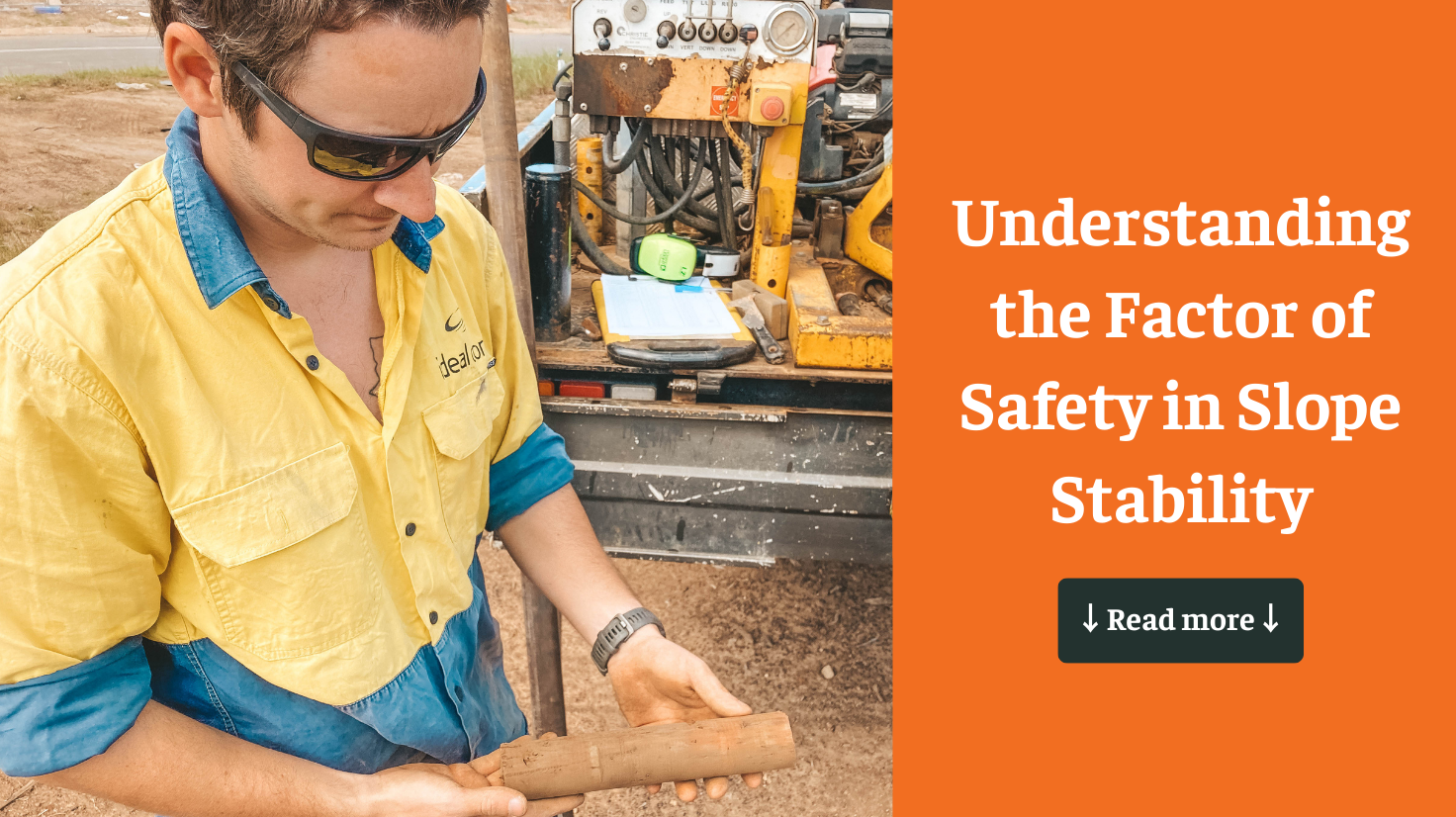When evaluating the stability of slopes, one of the most critical metrics is the Factor of Safety (FoS) for slope stability. This key concept in geotechnical engineering is essential for ensuring that slopes remain stable, thereby safeguarding infrastructure, natural landscapes, and human lives. In this guide, we’ll delve into the Factor of Safety, explore how it is calculated, and understand its importance in slope stability assessments.
1. What is the Factor of Safety?
The Factor of Safety (FoS) is a ratio used in geotechnical engineering to assess the stability of slopes. It compares the forces resisting slope movement (shear strength) against the forces driving the slope to fail (shear stress). An FoS greater than 1 indicates that the resisting forces exceed the driving forces, implying stability. Conversely, an FoS less than 1 suggests that the slope is unstable and likely to fail. In practical terms, the FoS provides engineers with a measure of how close a slope is to failure, serving as a critical benchmark in slope stability assessments.
2. How to Calculate the Factor of Safety?
The calculation of FoS involves several sophisticated methods, depending on the complexity of the slope and the materials involved. Here are a few common approaches:
a. Limit Equilibrium Methods: These methods are widely used for slope stability analysis. They involve dividing the slope into slices and evaluating the balance of forces on each slice. The overall stability is then determined by summing the forces across all slices. Common limit equilibrium methods include:
- Method of Slices: This involves dividing the slope into vertical slices and analyzing each for equilibrium of forces.
- Bishop’s Simplified Method: A more refined approach that considers both the moment equilibrium and the inter-slice forces.
- Janbu’s Method: Suitable for more complex slopes, this method accounts for non-vertical slices.
b. Numerical Simulations: Numerical methods, such as the Finite Element Method (FEM), model the slope as a continuum and simulate the stress-strain relationship within the soil. These models can handle complex geometries and heterogeneous materials, providing a more detailed analysis of slope behavior under various conditions.
c. Probabilistic Models: These models consider the variability in soil properties, geometry, and loading conditions. They provide a range of possible FoS values rather than a single deterministic value, offering insights into the likelihood of slope failure under different scenarios.
Example Calculation: Consider a slope with a height of 10 meters and an inclination angle of 30 degrees, composed of clayey soil with known shear strength parameters. Using the Method of Slices, the slope is divided into segments, and the forces acting on each slice are computed. The FoS is then obtained by taking the ratio of the sum of resisting forces to the sum of driving forces.
3. Factors Influencing the Factor of Safety
Several factors can significantly influence the FoS for a slope, including:
a. Soil Properties: The type of soil, its cohesion, internal friction angle, and shear strength play a pivotal role in determining slope stability. For example, clayey soils, with their high cohesion, typically exhibit higher FoS compared to sandy soils under similar conditions.
b. Water Content: The presence of water within the soil can reduce its effective stress, thereby lowering the soil’s shear strength. Elevated pore water pressures, often caused by rainfall or poor drainage, can drastically decrease the FoS, leading to slope failure.
c. Slope Geometry: Steeper slopes are naturally less stable, as the driving forces due to gravity are higher. The height of the slope also matters, with taller slopes generally having lower FoS.
d. External Loads: Additional loads on the slope, such as buildings, roads, or even vehicles, can increase the driving forces, thereby reducing the FoS.
e. Seismic Activity: In regions prone to earthquakes, seismic forces can significantly alter the balance of forces on a slope. Engineers must account for these dynamic loads when calculating the FoS, particularly in areas with a history of seismic activity.
4. Why is the Factor of Safety Important?
The Factor of Safety is not just a theoretical concept but a practical tool that influences the design and maintenance of slopes in real-world engineering projects. Its importance lies in several key areas:
a. Risk Management: A higher FoS provides a buffer against unexpected conditions, such as extreme weather events or changes in land use. By ensuring that slopes have a sufficient FoS, engineers can prevent catastrophic landslides and slope failures that could endanger lives and property.
b. Regulatory Compliance: Engineering standards and building codes often specify minimum FoS values for different types of slopes. Meeting or exceeding these standards is essential for legal compliance and project approval.
c. Infrastructure Longevity: Slopes with adequate FoS are less likely to experience failures over time, ensuring the longevity of infrastructure such as roads, railways, and embankments. This reduces maintenance costs and extends the service life of the infrastructure.
d. Environmental Protection: In natural landscapes, ensuring a high FoS helps protect ecosystems by preventing landslides that could destroy habitats, disrupt waterways, and cause long-term environmental damage.
5. Conclusion
The Factor of Safety in slope stability is a cornerstone of geotechnical engineering. It serves as a critical indicator of the stability and safety of slopes, whether in natural terrains or engineered structures. Understanding and accurately calculating the FoS allows engineers to design slopes that are not only stable but also resilient against a range of potential hazards.
6. Contact Ideal Geotech for Expert Slope Stability Assessments
At Ideal Geotech, we are dedicated to providing top-tier geotechnical solutions, including thorough slope stability assessments. Our experienced team uses cutting-edge techniques to calculate and optimize the Factor of Safety for slope stability, ensuring the safety and success of your projects.
Whether you’re embarking on a new project or need to assess the stability of existing slopes, Ideal Geotech is your go-to partner for reliable, expert guidance. Contact us today to learn more about how we can assist with your geotechnical needs and help you achieve a stable and secure foundation for your projects.
Order Our Geotechnical Services Now







